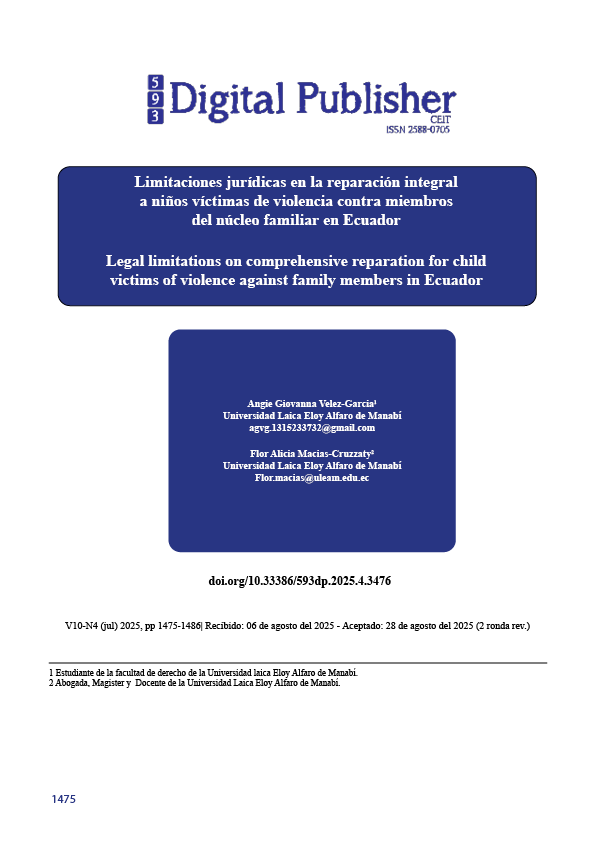Legal limitations on comprehensive reparation for child victims of violence against family members in Ecuador
Main Article Content
Abstract
The State's response to this problem cannot be limited to the criminal sanction of the aggressors, but must incorporate effective mechanisms of comprehensive reparation that ensure the restitution of the victim's life plan, the guarantee of non-repetition and the restoration of decent living conditions. In the Ecuadorian context, the protection of the rights of children and adolescents in the face of domestic violence has been expressly recognized in the Constitution of the Republic of Ecuador , which establishes that the best interests of the child constitute a priority obligation of attention for the State, society and the family . In accordance with this provision, the Comprehensive Organic Criminal Code , in force since 2014, develops the concept of comprehensive reparation in its article 78, indicating that victims of criminal offenses have the right to receive non-exclusive measures of restitution, rehabilitation, compensation, satisfaction and guarantees of non-repetition. Indeed, the current legal framework does not provide for specific mechanisms requiring state institutions to guarantee systematic, long-term institutional follow-up for children who have been victims of domestic violence. This omission raises questions about the real effectiveness of the right to full reparation and reveals a regulatory gap that directly affects the ability of minors to effectively restore their full development after being exposed to violent dynamics within the family.
Downloads
Article Details

This work is licensed under a Creative Commons Attribution-NonCommercial-ShareAlike 4.0 International License.
1. Derechos de autor
Las obras que se publican en 593 Digital Publisher CEIT están sujetas a los siguientes términos:
1.1. 593 Digital Publisher CEIT, conserva los derechos patrimoniales (copyright) de las obras publicadas, favorece y permite la reutilización de las mismas bajo la licencia Licencia Creative Commons 4.0 de Reconocimiento-NoComercial-CompartirIgual 4.0, por lo cual se pueden copiar, usar, difundir, transmitir y exponer públicamente, siempre que:
1.1.a. Se cite la autoría y fuente original de su publicación (revista, editorial, URL).
1.1.b. No se usen para fines comerciales u onerosos.
1.1.c. Se mencione la existencia y especificaciones de esta licencia de uso.
References
Carranco, M. (2021). Reparación integral con enfoque estructural en Ecuador. Revista Ecuatoriana de Derecho Constitucional, 33(2), 141–169.
Carrillo, J., & Parra, L. (2022). Justicia restaurativa y reparación integral: una mirada desde el derecho penal ecuatoriano. Revista Iuris Dictio, 30(1), 55–78.
Rivadeneira, G. (2019). Infancia y garantías constitucionales en el sistema penal. Revista de Ciencias Sociales y Jurídicas, 22(3), 89–110.
Shelton, D. (2005). Remedies in International Human Rights Law (2nd ed.). Oxford University Press.
Comité de los Derechos del Niño. (2011). Observación General No. 13 sobre el derecho del niño a no ser objeto de ninguna forma de violencia. Organización de las Naciones Unidas.
Legisgrafía
Asamblea Nacional del Ecuador. (2008). Constitución de la República del Ecuador. Registro Oficial Suplemento No. 449.
Asamblea Nacional del Ecuador. (2014). Código Orgánico Integral Penal. Registro Oficial Suplemento No. 180.
Asamblea Nacional del Ecuador. (2003). Código de la Niñez y Adolescencia. Registro Oficial No. 737.
Asamblea Nacional del Ecuador. (2018). Ley Orgánica Integral para Prevenir y Erradicar la Violencia contra las Mujeres. Registro Oficial Suplemento No. 175.
Organización de las Naciones Unidas. (1989). Convención sobre los Derechos del Niño.
Organización de Estados Americanos. (1969). Convención Americana sobre Derechos Humanos (Pacto de San José).
Organización de las Naciones Unidas. (1966). Pacto Internacional de Derechos Civiles y Políticos.
Congreso de Colombia. (1989). Decreto 2737 de 1989 por el cual se expide el Código del Menor. Diario Oficial No. 39.076.
Congreso de la Nación Argentina. (2005). Ley 26.061: Ley de Protección Integral de los Derechos de las Niñas, Niños y Adolescentes. Boletín Oficial 21/10/2005.
Jurisprudencia
Corte Constitucional del Ecuador. (2016). Sentencia No. 183-16-SEP-CC.
Corte Constitucional del Ecuador. (2021). Sentencia No. 0507-13-EP/21.
Corte Constitucional del Ecuador. (2020). Sentencia No. 253-20-JP/20.
Corte Constitucional del Ecuador. (2016). Sentencia No. 006-16-SIN-CC.
Corte Constitucional del Ecuador. (2022). Sentencia No. 1149-17-EP/22.
Corte Interamericana de Derechos Humanos. (1988). Caso Velásquez Rodríguez vs. Honduras. Sentencia de 29 de julio de 1988.
Corte Interamericana de Derechos Humanos. (2009). Caso González y otras (“Campo Algodonero”) vs. México. Sentencia de 16 de noviembre de 2009.
Corte Interamericana de Derechos Humanos. (2018). Caso Ramírez Escobar y otros vs. Guatemala. Sentencia de 9 de marzo de 2018.



